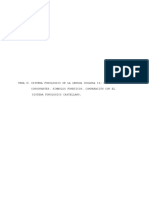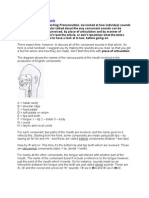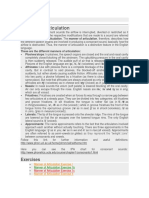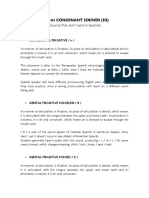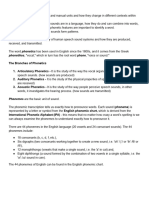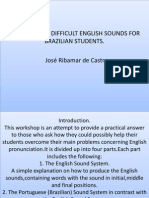Consonants
Consonants
Uploaded by
Faisal AkbarCopyright:
Available Formats
Consonants
Consonants
Uploaded by
Faisal AkbarCopyright
Available Formats
Share this document
Did you find this document useful?
Is this content inappropriate?
Copyright:
Available Formats
Consonants
Consonants
Uploaded by
Faisal AkbarCopyright:
Available Formats
English Phonetics and Phonology
Fernando Trujillo
The consonants
Plosives
Perhaps plosives are the easiest sounds to teach and learn in an English-Spanish 2LL course. Plosives are defined as consonant sounds which involve, first, a stricture of the mouth that allows no air to escape from the vocal tract and, second, the compression and release of the air. So, there are four phases in the production of plosives: closure, hold, release and post-release. English has six plosive consonants, p, t, k, b, d, g. /p/ and /b/ are bilabial, that is, the lips are pressed together. /t/ and /d/ are alveolar, so the tongue is pressed against the alveolar ridge. /k/ and /g/ are velar; the back of the tongue is pressed against an intermediate area between the hard and the soft palate. /p/, /t/ and /k/ are voiceless. /b/, /d/ and /g/ are normally voiced. The release of the voiceless plosives is followed by audible plosion and, in the postrelease phase, by an aspiration. So, the most noticeable difference between the voiceless and the voiced plosives is this aspiration. In VC position, the vowels preceding the voiceless plosives are much shorter. Place of articulation bilabial alveolar Velar Voiceless p t K Voiced b d G
Fricatives and Affricates
Fricatives are characterised by a hissing sound which is produced by the air escaping through a small passage in the mouth. Affricates begin as plosives and end as fricatives. These are homorganic sounds, that is, the same articulator produces both sound, the plosive and the fricative. Place of articulation labiodental dental alveolar Palato-alveolar Glottal Voiceless F s h Voiced V z Fricatives Voiceless fricatives have the effect of shortening the preceding vowel, in the same way as voiceless plosives. Place of articulation Palato-alveolar Voiceless t Voiced d Affricates
English Phonetics and Phonology
Fernando Trujillo
Nasals
The basic feature of a nasal is that the air escapes through the nose and the main difference between the three types of nasals is the point where the air is stopped in the mouth. In this sense, there are three types of nasals: bilabial /m/, alveolar /n/ and velar //. This last velar sound never occurs in initial position; in medial position, it may appear with or without a /g/ sound, depending on whether it occurs at the end of a morpheme or not. If it occurs in the middle of a morpheme it has a following /g/. In final position the preceding rule is observed. Bilabial Alveolar Velar Nasals m n
Lateral /l/
A lateral consonant is one in which air escapes from the mouth along the sides of the tongue. The only additional information about the lateral /l/ is the existence of a clear /l/ at initial position and a dark /l/, when it is final or medial preceding a consonant. The dark /l/ is similar to an /u/ vowel.
Approximant /r/
The approximant /r/ is produced by the tip of the tongue approaching the alveolar area but it never touches it. Besides, the tongue is slightly curled backwards with the tip raised (this is called to be retroflex). In RP this sound only occurs before vowels. However, many accents of English do pronounce /r/ after vowels. This is the difference between non-rhotic and rhotic accents.
/j/ and /w/
These two sounds are phonetically vowels but phonologically consonants. That is, phonetically they are pronounced as /i:/ and /u:/ but a little bit shorter. But, then, they only occur before vowel phonemes.
You might also like
- Fricative and AffricateDocument3 pagesFricative and AffricateShyamal Kanti Das100% (2)
- The Mystery of the Seven Vowels: In Theory and PracticeFrom EverandThe Mystery of the Seven Vowels: In Theory and PracticeRating: 4 out of 5 stars4/5 (9)
- Types of Phonemes Definitions PDFDocument3 pagesTypes of Phonemes Definitions PDFLovely Finuliar100% (1)
- Tema 8: Sistema Fonologico de La Lengua Inglesa Ii: Las Consonantes. Simbolos Foneticos. Comparación Con El Sistema Fonologico CastellanoDocument14 pagesTema 8: Sistema Fonologico de La Lengua Inglesa Ii: Las Consonantes. Simbolos Foneticos. Comparación Con El Sistema Fonologico CastellanoLorraineNo ratings yet
- Lecture 3 English ConsonantsDocument21 pagesLecture 3 English Consonantsshah khalidNo ratings yet
- الثاني صوتDocument13 pagesالثاني صوتg7j85hvb52No ratings yet
- The Distinctive CompositionDocument5 pagesThe Distinctive Compositionsofija manaievaNo ratings yet
- English ConsonantsDocument3 pagesEnglish ConsonantsKashif Farid0% (1)
- Phonetics NotesDocument5 pagesPhonetics NotesYaya CasablancaNo ratings yet
- Fonetic NotesDocument5 pagesFonetic Notessteamimon2No ratings yet
- Opos-Unit 8Document9 pagesOpos-Unit 8rbellaubNo ratings yet
- Introduction To ENG ConsonantsDocument4 pagesIntroduction To ENG Consonantskamsyplus1676No ratings yet
- Phonetic and Phonology II HANDOUTDocument6 pagesPhonetic and Phonology II HANDOUTannerysNo ratings yet
- Manner of Articulation: ExercisesDocument1 pageManner of Articulation: ExercisesHomero Apeña CarranzaNo ratings yet
- Idiot BoardDocument3 pagesIdiot BoardPaulynne Ericka MiguelNo ratings yet
- Places of Articulation: in What Area of Oral Cavity A Consonant Is ProducedDocument7 pagesPlaces of Articulation: in What Area of Oral Cavity A Consonant Is ProducedShanti.R. AfrilyaNo ratings yet
- Manner of Articulation DefinitionDocument9 pagesManner of Articulation DefinitionAdmin LinguizNo ratings yet
- Vowels and Consonants: Ahmad BakhtiarDocument22 pagesVowels and Consonants: Ahmad BakhtiarAdenito Tri MulyanaNo ratings yet
- Consonants and Allophonic VariationDocument33 pagesConsonants and Allophonic VariationAgustina AcostaNo ratings yet
- PhonologyDocument13 pagesPhonologyyszvvzjnd5No ratings yet
- Phonetics and PhonologyDocument49 pagesPhonetics and PhonologyPatricio Sepulveda100% (1)
- Fonetica ResumenDocument8 pagesFonetica ResumenLaura MansillaNo ratings yet
- English Vowels & Consonants_PronunciationDocument35 pagesEnglish Vowels & Consonants_Pronunciationsarkarsudipta05102003No ratings yet
- DoeDocument93 pagesDoeIron ManNo ratings yet
- Department of EnglishDocument93 pagesDepartment of EnglishUosra SaeedNo ratings yet
- Consonant Sounds in English: Lateral Semi-Vowels Retroflex ApproximantDocument3 pagesConsonant Sounds in English: Lateral Semi-Vowels Retroflex ApproximantSujatha MenonNo ratings yet
- English Consonant Sounds III (Sounds Not Existing in Spanish)Document6 pagesEnglish Consonant Sounds III (Sounds Not Existing in Spanish)Jazmin SanabriaNo ratings yet
- ConsonantsDocument2 pagesConsonantsMariluz BelloNo ratings yet
- The Place of ArticulationDocument4 pagesThe Place of Articulationcandygold66No ratings yet
- Elision of Vowels: Phonetic IiDocument7 pagesElision of Vowels: Phonetic IiJimena CardozoNo ratings yet
- Consonant SoundsDocument8 pagesConsonant SoundsKhairul Nizam HamzahNo ratings yet
- PhonologyDocument18 pagesPhonologyNour el houda ManaiNo ratings yet
- English ConsonantsDocument28 pagesEnglish ConsonantsIzzati AzmanNo ratings yet
- CONSONANTSDocument6 pagesCONSONANTSnadia nur ainiNo ratings yet
- CONSONANTAL SOUNDS Lez 7Document7 pagesCONSONANTAL SOUNDS Lez 7silviasNo ratings yet
- MAnner of ArticulationDocument1 pageMAnner of Articulationnasreenkousar053No ratings yet
- Comparative LinguisticsDocument20 pagesComparative LinguisticsمنىالنارNo ratings yet
- النظام الصوتي المرحلة الاولى الملف الكاملDocument48 pagesالنظام الصوتي المرحلة الاولى الملف الكاملjyx9sbghgvNo ratings yet
- Consonants of English: Presented by Marwa Mahmoud Abd El FattahDocument8 pagesConsonants of English: Presented by Marwa Mahmoud Abd El FattahSamar Saad100% (2)
- Notes On PhonologyDocument8 pagesNotes On PhonologyparsomalaleahNo ratings yet
- Tugas PhonologyDocument4 pagesTugas PhonologyJuwita AnggreliaNo ratings yet
- NGỮ ÂMDocument11 pagesNGỮ ÂMVân HảiNo ratings yet
- Phonetics & Silent and Non Silent LettersDocument9 pagesPhonetics & Silent and Non Silent Letterssrisridharan0303No ratings yet
- Allophonic Variants For English ConsonantsDocument11 pagesAllophonic Variants For English ConsonantsSergio Vargas0% (1)
- Glossary of Phonetic TerminologyDocument8 pagesGlossary of Phonetic TerminologyFlorencia Palacios ReyNo ratings yet
- Place and Manner of Articulation ConsonantsDocument29 pagesPlace and Manner of Articulation ConsonantslouelleNo ratings yet
- Chapter 4 & 5 - Special TopicsDocument15 pagesChapter 4 & 5 - Special TopicsBearish PaleroNo ratings yet
- Mod5 Iluko PhonologyDocument11 pagesMod5 Iluko PhonologyLara Angela RigorNo ratings yet
- PHONOLOGY Overview PronunciationDocument11 pagesPHONOLOGY Overview PronunciationPaul HughesNo ratings yet
- Phonology 5658Document29 pagesPhonology 5658Shaukat Hussain AfridiNo ratings yet
- Manner of ArticulationDocument12 pagesManner of ArticulationMhonz Limbing100% (1)
- PHONOLOGY I - Consonants - Part 1 (3)Document13 pagesPHONOLOGY I - Consonants - Part 1 (3)Amparo LanghiNo ratings yet
- File 000Document12 pagesFile 000k4nii.kamallNo ratings yet
- Phonetics and Phonology I - Plosives and AffricatesDocument15 pagesPhonetics and Phonology I - Plosives and AffricatesMaríaDeLosAngelesHeld100% (3)
- Lecture 1lecture 1.Document2 pagesLecture 1lecture 1.TinBowNo ratings yet
- Dealing With Difficult English Sounds For Brazilian StudentsDocument33 pagesDealing With Difficult English Sounds For Brazilian StudentsCaio AntônioNo ratings yet
- Consonant SoundsDocument20 pagesConsonant SoundsRoselyn Lictawa Dela Cruz100% (1)
- linguisticsDocument18 pageslinguisticshafizhanzla shahNo ratings yet
- Consonants and Vowels Distinguish Between Consonants and Vowels and Describe How Consonants Are ClassifiedDocument3 pagesConsonants and Vowels Distinguish Between Consonants and Vowels and Describe How Consonants Are ClassifiedThiên ThanhNo ratings yet



